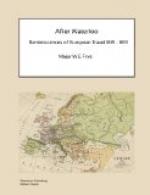On my return to the inn, I met with a Dutch clergyman who was travelling with his pupils, three very fine boys, the sons of a Dutch lady of rank. He was to conduct them to the University of Neuwied, on the right bank of the Rhine, in order to place them there for their education. The young men seem to have profited much from their studies. Their tutor seemed to be a well-informed man and of liberal ideas; he preferred speaking German to French, as he said he had not much facility in expressing himself in the latter language. He said if I were going his way he would be happy to have the pleasure of my company, to which I very willingly acceded, and we agreed to start the next morning early so as to arrive at Bonn to breakfast, and then to go on to Godesberg, where he proposed to remain a few days.
From the windows of our inn we have a fine view of the river, and I have not omitted doing hommage to old Father Rhine by taking up some of his water in the hollow of my hand to drink. The Rhine of later years has been considered the guardian of Germany against the hostile incursions of the French, and Schiller represents this river as a Swiss vigilant on his post, yet in spite of his vigilance and fidelity unable to prevent his restless neighbour from forcing his safeguard. The following are the lines of Schiller where the river speaks in a distich:
Treu wie dem Schwfeizer gebuehrt bewach’ich
Germaniens Grenze,
Aber der Gallier huepft ueber den duldenden
Strom.
In vain my stream I interpose
To guard Germania’s
realm from foes;
The nimble Gauls my cares
deride
And often leap on t’other
side.
GODESBERG, 4th July.
The distance from Cologne to Bonn is 18 miles and Godesberg is three miles further. We stopped to breakfast at Bonn and after breakfast made a promenade thro’ the city. Bonn is a handsome, clean, well-built and cheerful looking city and the houses are good and solid.
The Electoral Palace is a superb building, but is not occupied and is falling rapidly to decay. From the terrace in the garden belonging to this Palace, which impends over the Rhine, you have a fine view of this noble river. This Palace was at one time made use of as a barrack by the French, and since the secularization of the Ecclesiastical Electorates it has not been thought worth while to embellish or even repair it. There is a Roman antiquity in this town called the Altar of Victory, erected on the Place St Remi, but remarkable for nothing but its antiquity; it seems to be a common Roman altar.[23] The road from Bonn to Godesberg is three miles in length and thro’ a superb avenue of horse-chesnut trees; but before you arrive at Godesberg, there is on the left side of the road a curious specimen of Gothic architecture called Hochkreutz, very like Waltham cross in appearance, but much higher and in better preservation; it was erected by some feudal Baron to expiate a homicide. The castle of Godesberg is situated on an eminence and commands a fine prospect; it is now a mass of rums and the walls only remain. It derives its name of Godesberg or Goetzenberg from the circumstance of its having been formerly the site of a temple of Minerva built in the time of the Romans, and thence called Goetzenberg by the Christians, Goetze in German signifying an idol.




